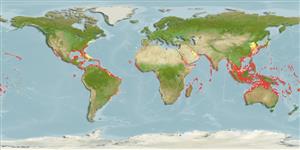分类 / Names
俗名 | 同种异名 | Catalog of Fishes(属, 种) | ITIS | CoL | WoRMS | Cloffa
Elasmobranchii
板鳃亚纲 (鲨鱼与 鱼) (sharks and rays) >
Myliobatiformes (Stingrays) >
Aetobatidae (Pacific eagle rays)
Etymology: Aetobatus: Greek, aetos = eagle + Greek, batis, batidos = a ray (Raja sp.) (Ref. 45335).
Issue
Status of Aetobatus latirostris Duméril, 1861 requires further investigation. Species information (common names) should be linked to correct species (see Ref. 114963).
Environment: milieu / climate zone / depth range / distribution range
生态学
海洋; 半咸淡水 底中水层性; 非产卵性溯降河的 (Ref. 51243); 深度上下限 1 - 80 m (Ref. 9710). 亞熱帶的; 36°N - 24°S, 98°W - 15°E
Western Atlantic and probably Eastern Atlantic. Indo-Pacific species refer to Aetobatus ocellatus; Eastern Pacific species refers to A. laticeps.
西大西洋: 北卡羅萊那州 (夏天) 與美國的佛羅里達與百慕達群島到巴西南部。 在墨西哥灣與加勒比海各處, 包括安地列斯群島.(參考文獻 26938) 東大西洋: 茅利塔尼亞到安哥拉.(參考文獻 4440) 印度-西太平洋: 紅海與南非至夏威夷,北至日本, 南至澳洲.(參考文獻 9862) 東太平洋: 加州灣到祕魯的波多立哥皮薩羅與加拉巴哥群島.(參考文獻 5530) 在那裡可能是有斑點 Aetobatus 的超過一個種。 (參考文獻 9862)
Length at first maturity / 大小 / 重量 / 年龄
Maturity: Lm 107.4, range 110 - 120 cm
Max length : 230 cm WD 雄鱼/尚未辨别雌雄; (Ref. 114953); common length : 140 cm WD 雄鱼/尚未辨别雌雄; (Ref. 114953); 最大体重: 230.0 kg (Ref. 7251)
简单描述
检索表 | 型态特徵 | 形态测量图
背棘 (总数) : 0; 臀棘: 0. An eagleray with a long snout, flat and rounded like a duck's bill, a thick head, and a pectoral disc with sharply curved, angular corners, and no caudal fin; jaws usually with single row of flat, chevron-shaped teeth (Ref. 5578). Each tooth a crescent-shaped plate joined into a band (Ref. 26938). Numerous white spots on black or bluish disc; white below (Ref. 5578). Long whiplike tail, with a long spine near the base, behind small dorsal fin. No spines on disk (Ref. 7251).
一个鹰 具有一个长的吻, 平坦的而且像一个鸭子的嘴,一个厚的头部圆的, 与一个胸盘具有锐利的弯曲, 棱角 , 与没有尾鳍; 颚通常有单列的平且锯齿形的齿。 (参考文献 5578) 每个牙齿一个新月形的碟结合成一箍了.(参考文献 26938) 在黑色或蓝色的体盘上的很多的白色斑点; 腹面白色的.(参考文献 5578) 在小的背鳍后面,长的鞭状尾部,具有一个在基底附近的长的棘。 没有在圆盘上的棘.(参考文献 7251)
Commonly found in coastal habitats to at least 60 m depth (Ref. 114953). Swims close to the surface, occasionally leaping out of the water, or close to the bottom (Ref. 3175). Frequently forming large schools during the non-breeding season (Ref. 7251). Feeds on polychaetes, bivalves, gastropods, cepahlopods, shrimps and small fishes (Ref. 114953). Ovoviviparous (Ref. 50449). Bears young in litters of 2-4 (Ref. 26938, 114953).
普遍地栖息于沿岸浅水区水域例如海湾,而且珊瑚礁但是可能交叉的大洋性的流域。 (参考文献 9862) 有时进入河口。 (参考文献 6871) 游泳接近表面,偶然地从水中跳出来, 或接近底部.(参考文献 3175) 时常在非繁殖季节的时候形成大群鱼群。 (参考文献 7251) 主要吃二枚贝也吃虾,螃蟹,章鱼与蠕虫,蛾螺与小鱼.(参考文献 9862) 卵胎生的.(参考文献 50449) 肉可食用的.(参考文献 30573) 最大的长度 880 公分TL.(参考文献 30573) 在胎窝生产幼鱼4.(參考文獻 26938) 尾部用作了一個裝飾的項目。 (參考文獻 27550)
Life cycle and mating behavior
Maturities | 繁殖 | Spawnings | Egg(s) | Fecundities | 仔鱼
Exhibit ovoviparity (aplacental viviparity), with embryos feeding initially on yolk, then receiving additional nourishment from the mother by indirect absorption of uterine fluid enriched with mucus, fat or protein through specialised structures (Ref. 50449). Bears up to 4 young (Ref. 5578, 6871, 37816). Width at birth 17-35 cm (Ref. 37816).
According to Uchida et al (1990) (Ref. 51119) 'the male chases the female in mid water, then nibbles on her dorsal surface. The female stops swimming to begin copulation. The male bites the female on a pectoral fin and bends one clasper forward, then attempts an abdomen to abdomen copulation with either clasper, usually mid-water' (Ref. 49562). Copulation lasted for 20 seconds to 1 minute (Ref. 49562).西大西洋: 北卡羅萊那州 (夏天) 與美國的佛羅里達與百慕達群島到巴西南部。 在墨西哥灣與加勒比海各處, 包括安地列斯群島.(參考文獻 26938) 東大西洋: 茅利塔尼亞到安哥拉.(參考文獻 4440) 印度-西太平洋: 紅海與南非至夏威夷,北至日本, 南至澳洲.(參考文獻 9862) 東太平洋: 加州灣到祕魯的波多立哥皮薩羅與加拉巴哥群島.(參考文獻 5530) 在那裡可能是有斑點 Aetobatus 的超過一個種。 (參考文獻 9862)
Last, P.R., W.T. White, M.R. de Carvalho, B. Séret, M.F.W. Stehmann and G.J.P. Naylor, 2016. Rays of the world. CSIRO Publishing, Comstock Publishing Associates. i-ix + 1-790. (Ref. 114953)
世界自然保护联盟红皮书 (Ref. 130435)
濒危 (EN) (A2bd); Date assessed: 28 July 2020
人类利用
渔业: 低经济
工具
特别资料
下载 XML
网络资源
Estimates based on models
Preferred temperature (Ref.
123201): 22.3 - 29, mean 27.5 °C (based on 4014 cells).
Phylogenetic diversity index (Ref.
82804): PD
50 = 0.6250 [Uniqueness, from 0.5 = low to 2.0 = high].
Bayesian length-weight: a=0.01000 (0.00244 - 0.04107), b=3.04 (2.81 - 3.27), in cm total length, based on all LWR estimates for this body shape (Ref.
93245).
营养阶层 (Ref.
69278): 4.2 ±0.1 se; based on diet studies.
回复力 (Ref.
120179): 非常低的, 最小族群倍增时间超过14 年 (tm=4-6; Fec=1-2).
Prior r = 0.06, 95% CL = 0.04 - 0.09, Based on 1 data-limited stock assessment.
Fishing Vulnerability (Ref.
59153): Very high vulnerability (85 of 100).
Nutrients (Ref.
124155): Calcium = 9.92 [1.89, 44.45] mg/100g; Iron = 0.495 [0.123, 1.361] mg/100g; Protein = 22 [17, 27] %; Omega3 = 0.253 [0.077, 0.713] g/100g; Selenium = 25.2 [7.7, 73.8] μg/100g; VitaminA = 8.16 [2.83, 22.84] μg/100g; Zinc = 0.526 [0.255, 0.991] mg/100g (wet weight);
